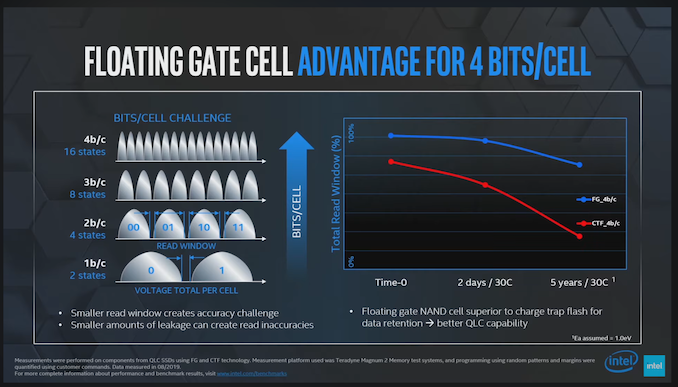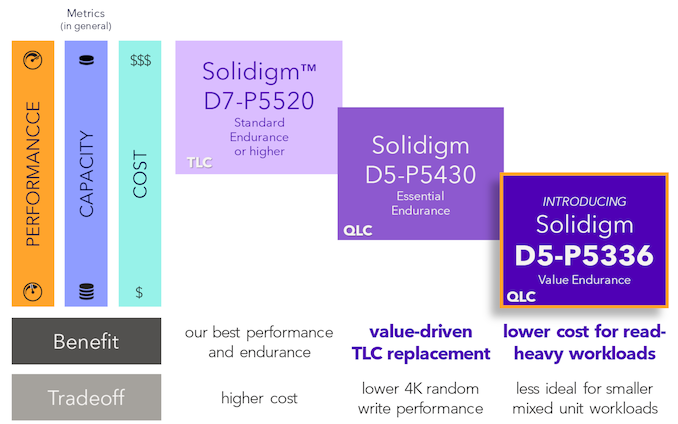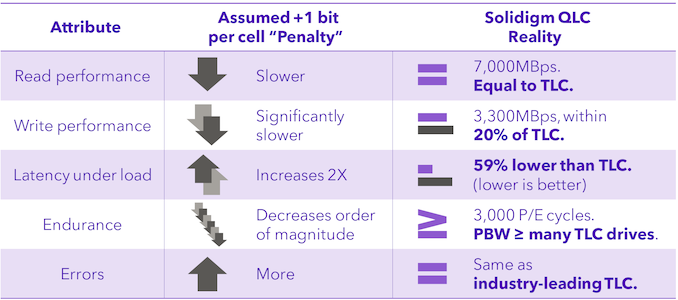Solidigm Announces D5-P5336: 64 TB-Class Data Center SSD Sets NVMe Capacity Records
by Ganesh T S on July 20, 2023 11:00 AM EST- Posted in
- Storage
- SSDs
- Datacenter
- Enterprise SSDs
- QLC
- Solidigm

Advancements in flash technology have come as a boon to data centers. Increasing layer counts coupled with better vendor confidence in triple-level (TLC) and quad-level cells (QLC) have contributed to top-line SSD capacities essentially doubling every few years. Data centers looking to optimize storage capacity on a per-rack basis are finding these top-tier SSDs to be an economically prudent investment from a TCO perspective.
Solidigm was one of the first vendors to introduce a 32 TB-class enterprise SSD a few years back. The D5-P5316 utilized Solidigm's 144L 3D QLC NAND. The company has been extremely bullish on QLC SSDs in the data center. Compared to other flash vendors, the company has continued to use a floating gate cell architecture while others moved on to charge trap configurations. Floating gates retain programmed voltage levels for a longer duration compared to charge trap (ensuring that the read window is much longer without having to 'refresh' the cell). The tighter voltage level retaining capability of the NAND architecture has served Solidigm well in bringing QLC SSDs to the enterprise market.

Source: The Advantages of Floating Gate Technology (YouTube)
Solidigm is claiming that their 192L 3D QLC is extremely competitive against TLC NAND from its competitors that are currently in the market (read, Samsung's 136L 6th Gen. V-NAND and Micron's 176L 3D TLC).
Solidigm segments their QLC data center SSDs into the 'Essential Endurance' and 'Value Endurance' lines. Back in May, the company introduced the D5-P5430 as a drop-in replacement for TLC workloads. At that time, the company had hinted at a new 'Value Endurance' SSD based on their fourth generation QLC flash in the second half of the year. The D5-P5336 announced recently is the company's latest and greatest in the 'Value Endurance' line.

Solidigm's 2023 Data Center SSD Flagships by Market Segment
The D5-P5316 used a 64KB indirection unit (IU) (compared to the 4KB used in normal TLC data center SSDs). While endurance and speeds were acceptable for specific types of workloads that could avoid sub-64KB writes, Solidigm has decided to improve matters by opting for a 16KB IU in the D5-P5336.
Thanks to the increased layer count, Solidigm is able to offer the D5-P5336 in capacities up to 61.44 TB. This takes the crown for the highest capacity in a single NVMe drive, allowing a single 1U server with 32 E1.L versions to hit 2 PB. For a 100 PB solution, Solidigm claims up to 17% lower TCO against the best capacity play from its competition (after considering drive and server count as well as total power consumption).
| Solidigm D5-P5336 NVMe SSD Specifications | ||||
| Aspect | Solidigm D5-P5336 | |||
| Form Factor | 2.5" 15mm U.2 / 7.5mm E3.S / 9.5mm E1.L | |||
| Interface, Protocol | PCIe 4.0 x4 NVMe 1.4c | |||
| Capacities | U.2 7.68 TB, 15.36 TB, 30.72 TB, 61.44 TB |
E3.S 7.68 TB, 15.36 TB, 30.72 TB |
E1.L 15.36 TB, 30.72 TB, 61.44 TB |
|
| 3D NAND Flash | Solidigm 192L 3D QLC | |||
| Sequential Performance (GB/s) | 128KB Reads @ QD 128 | 7.0 | ||
| 128KB Writes @ QD 128 | 3.3 | |||
| Random Access (IOPS) | 4KB Reads @ QD 256 | 1005K | ||
| 16KB Writes @ QD 256 | 43K | |||
| Latency (Typical) (us) | 4KB Reads @ QD 1 | ?? | ||
| 4KB Writes @ QD 1 | ?? | |||
| Power Draw (Watts) | 128KB Sequential Read | ?? | ||
| 128KB Sequential Write | 25.0 | |||
| 4KB Random Read | ?? | |||
| 4KB Random Write | ?? | |||
| Idle | 5.0 | |||
| Endurance (DWPD) | 100% 128KB Sequential Writes | ?? | ||
| 100% 16KB Random Write | 0.42 (7.68 TB) to 0.58 (61.44 TB) | |||
| Warranty | 5 years | |||
Note that Solidigm is stressing endurance and performance numbers for IU-aligned workloads. Many of the interesting aspects are not yet known as the product brief is still in progress.
Ultimately, the race for the capacity crown comes with tradeoffs. Similar to hard drives adopting shingled-magnetic recording (SMR) to eke out extra capacity at the cost of performance for many different workload types, Solidigm is adopting a 16KB IU with QLC NAND optimized for read-intensive applications. Given the massive capacity per SSD, we suspect many data centers may find it perfectly acceptable (at least, endurance-wise) to use it in other workloads where storage density requirements matter more than write performance.
















18 Comments
View All Comments
anthony111 - Friday, July 21, 2023 - link
Yeah, the GP is a lot of vague FUD. I dunno about you but I tend to have actual “single cases” instead of whatever a statistical deployment is. There are certain companies you’ve heard of who buy QLC by the truckload. A bit too early??? QLC has been shipping for 5-6 years, and we’re on 3rd or 4th generation.I suspected that this 60TB SKU would have a larger IU just because of physical space for the FTL DRAM. 16KB is way less restrictive than the 64KB IU of the P5316. As an HDD replacement even a bit of space amp on tiny objects is more than compensated for by not having to limit spinners to 8TB and still suffering hotspots.
Atom11a - Friday, August 11, 2023 - link
It's easier to fool people than to convince them that they have been fooled. QLC will never replace TLC. Write speed is abysmal, endurance is crap, and data retention is far worse than TLC, meaning your data will evaporate without you knowing.anthony111 - Friday, July 21, 2023 - link
99% of SSDs never see more than 15% endurance burn.I know of a production QLC object storage deployment that sees 0.01 DWPD. 0.01. Any only needs tens of thousands on IOPS. Solidigm QLC is the holy grail for object storage given the RU density, as much as 3PB raw PER RU.
PeachNCream - Saturday, July 22, 2023 - link
Where did this information originate?"99% of SSDs never see more than 15% endurance burn."
Source please?
stanleyipkiss - Thursday, July 20, 2023 - link
Give me the 60 TB QLC SATA speed 2.5 inch or 3.5 inch SSD for $2000 and I'll buy 10.LiKenun - Thursday, July 20, 2023 - link
The 30.72 TB SKU is $1,800 on websites that list the new SSDs. The 61.44 TB SKU, which has not been listed anywhere, will probably be double the initially, but come down in price.I don’t believe Micron, which has 232-layer NAND, will cap its SSDs to 30.72 TB for much longer. More entrants into the high-density storage space is more than welcome.
PixyMisa - Thursday, July 20, 2023 - link
$60 per TB is not at all bad for this class of drive. Less than two years ago, $100 per TB was entry level.anthony111 - Friday, July 21, 2023 - link
Moreover, consider the TCO. The cost of the drive BAY not just unit cost per TB. DC RUs. Switches, racks, servers. SNIA’s TCO calculator is terrific for seeing the big picture, especially in the common situation of having to overbuy HDD capacity to get the IOPS you need. SSD $/IOPS >> spinners.